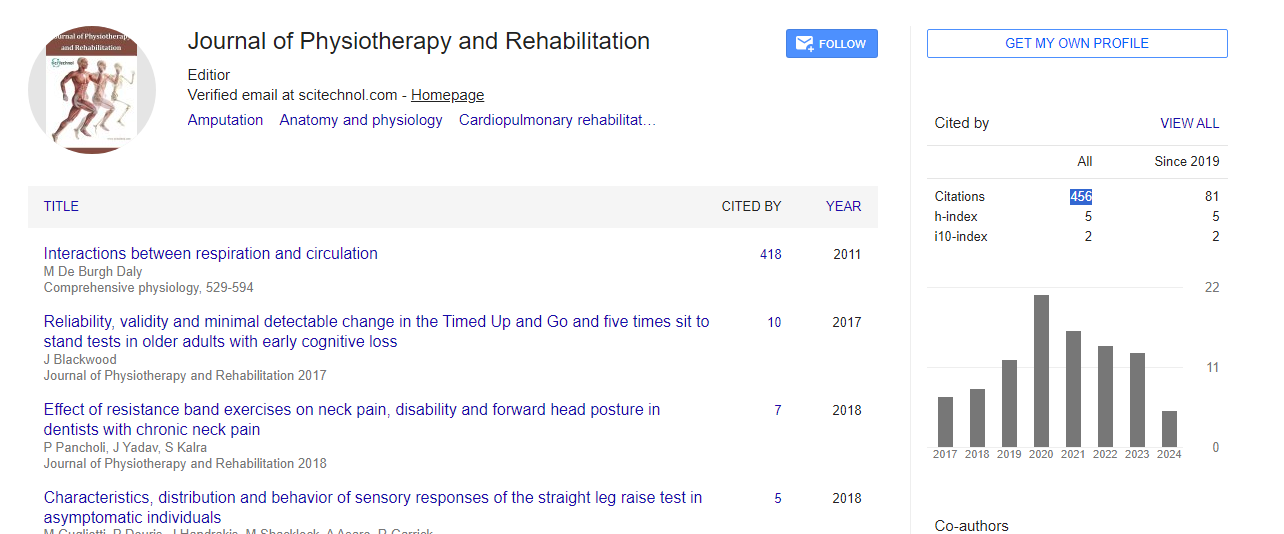Perspective, J Physiother Rehabi Vol: 8 Issue: 6
Strategies for Managing Post-COVID Fatigue and Breathlessness Through Targeted Rehabilitation Programs
Kong Gunel*
1Department of Physiotherapy, University of Lucerne, Lucerne, Switzerland
*Corresponding Author: Kong Gunel,
Department of Physiotherapy, University of
Lucerne, Lucerne, Switzerland
E-mail: gunelkong@rehan.ch
Received date: 23 November, 2024, Manuscript No. JPTR-24-155490;
Editor assigned date: 25 November, 2024, PreQC No. JPTR-24-155490 (PQ);
Reviewed date: 09 December, 2024, QC No. JPTR-24-155490;
Revised date: 17 December, 2024, Manuscript No. JPTR-24-155490 (R);
Published date: 24 December, 2024, DOI: 10.4172/JPTR.1000201.
Citation: Gunel K (2024) Strategies for Managing Post-COVID Fatigue and Breathlessness through Targeted Rehabilitation Programs. J Physiother Rehabi 8:6.
Description
Post-COVID fatigue and breathlessness are two of the most common and challenging symptoms experienced by individuals recovering from COVID-19. These symptoms, often lasting for weeks or even months after the acute phase of infection, can significantly impair a person’s quality of life, making it difficult to return to daily activities. Targeted rehabilitation programs have emerged as a essential component in managing these symptoms, focusing on restoring energy levels, improving lung function and enhancing overall physical endurance. Through a combination of physical therapy, breathing exercises and gradual activity progression, individuals can recover their strength and learn how to manage these symptoms effectively. Breathlessness or shortness of breath is another dominant symptom, even in patients who did not experience severe respiratory issues during the acute phase of the infection. Together, these two symptoms can create a cycle where fatigue leads to reduced physical activity, which in turn increase both fatigue and breathlessness. Targeted rehabilitation programs are designed to break this cycle and help individuals recover functionality. The first step in managing post-COVID fatigue and breathlessness is an individualized assessment conducted by healthcare professionals, including physiotherapists, occupational therapists and pulmonologists. This assessment focuses on evaluating the severity of symptoms, assessing lung function and determining the person’s physical capabilities.
One of the most effective strategies for managing fatigue and breathlessness is the gradual reintroduction of physical activity. A structured, progressive exercise program, designed to improve cardiovascular fitness and muscle strength, helps to rebuild stamina without overexertion. Rehabilitation programs typically start with lowimpact activities, such as walking or light stretching and slowly increase in intensity and duration over time. The aim is to prevent physical deconditioning while allowing the body to adjust to activity levels.
Aerobic exercises, like walking, cycling and swimming are particularly helpful in improving strength and oxygen uptake. These exercises improve circulation and increase energy levels by enhancing the body’s ability to deliver oxygen to the muscles. Strength training, such as light resistance exercises or bodyweight exercises, also helps to improve muscle strength and reduce feelings of weakness. Breathlessness can result from both physical deconditioning and residual lung damage caused by the infection. Pulmonary rehabilitation, a key part of post-COVID rehabilitation, focuses on breathing exercises to improve lung function and reduce shortness of breath. Techniques such as diaphragmatic breathing and pursed-lip breathing are commonly used to enhance the efficiency of the respiratory muscles and control breathlessness. Diaphragmatic breathing encourages deep breaths that engage the diaphragm, helping to improve lung expansion and oxygen exchange.
In addition to these breathing exercises, pulmonary rehabilitation may include supervised exercises to improve lung capacity and strengthen the muscles involved in breathing. For those experiencing significant breathlessness, the use of oxygen therapy may also be considered as part of the rehabilitation program to help with oxygen saturation levels during physical activity. For individuals dealing with persistent fatigue, energy conservation strategies are essential in reducing the overall impact of fatigue on daily activities. Occupational therapists often work with individuals to teach techniques that reduce energy expenditure while completing tasks. These techniques include pacing, prioritizing, and breaking tasks into smaller, more manageable steps. The emotional toll of post-COVID symptoms, including anxiety, depression and irritation can worsen fatigue and breathlessness. Psychological support, including counseling, cognitive-behavioral therapy and stress management techniques, is crucial in addressing the mental health aspect of recovery. Educating patients about the nature of post-COVID symptoms and the importance of pacing can help manage expectations and reduce stress. A key component of any rehabilitation program is continuous monitoring and adjustments based on progress.
Conclusion
Managing post-COVID fatigue and breathlessness requires a whole, personalized approach that combines physical rehabilitation with psychological support. By incorporating progressive exercise, pulmonary rehabilitation and energy conservation techniques, individuals can gradually recover strength, improve lung function and reduce symptoms. With the right support and a personalized plan, patients can overcome the challenges of post-COVID recovery and work towards resuming their daily activities with greater ease and confidence.
 Spanish
Spanish  Chinese
Chinese  Russian
Russian  German
German  French
French  Japanese
Japanese  Portuguese
Portuguese  Hindi
Hindi 